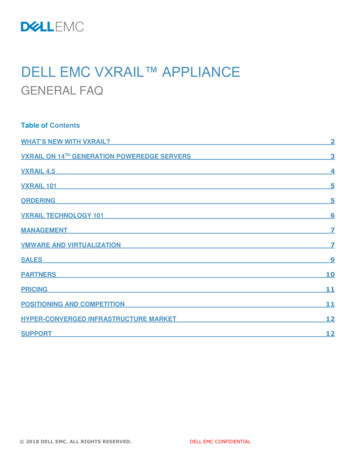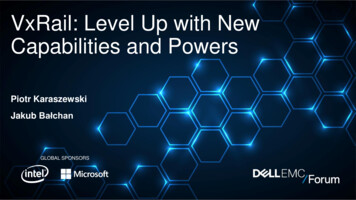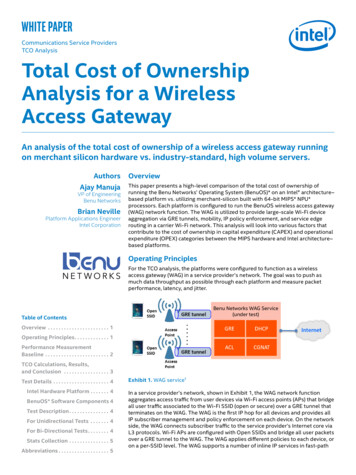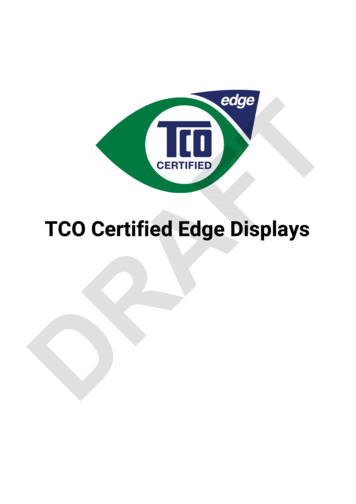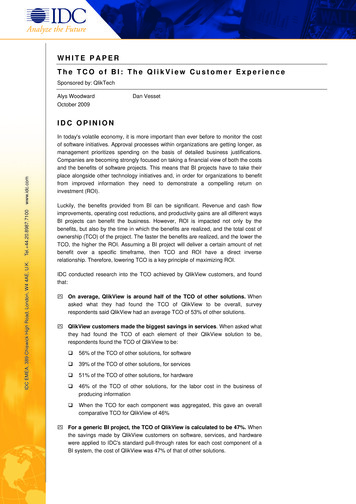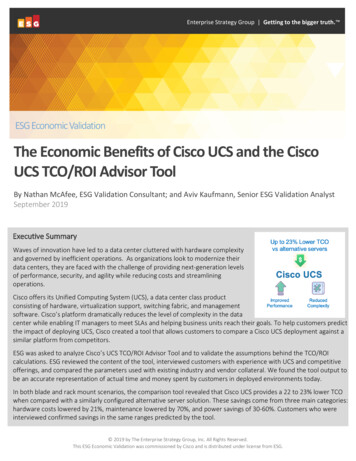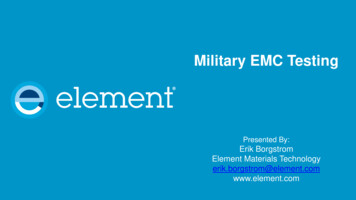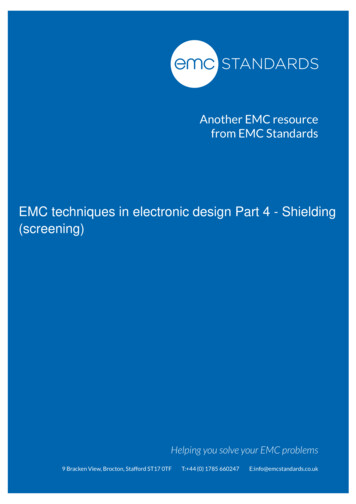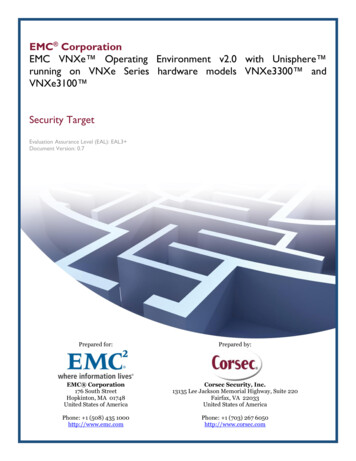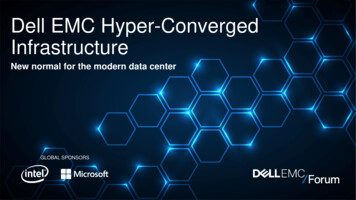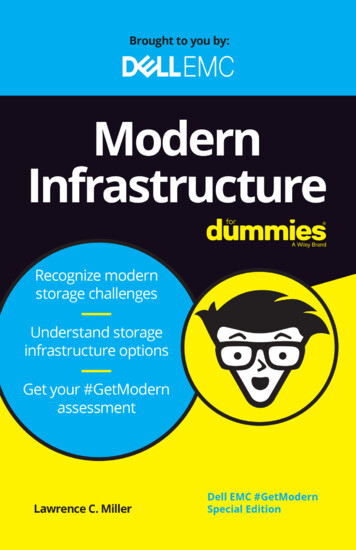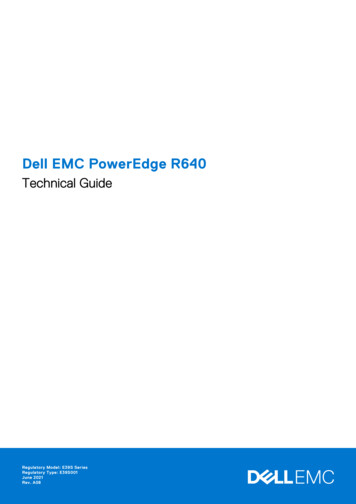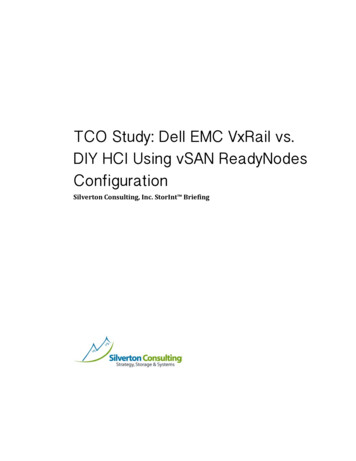
Transcription
TCO Study: Dell EMC VxRail vs.DIY HCI Using vSAN ReadyNodesConfigurationSilverton Consulting, Inc. StorInt Briefing
R2.0TCO STUDY: DELL EMC VXRAIL VS. DIY HCIPAGE 2 OF 21Executive Summary1This paper presents the results of a three-year total cost of ownership (TCO) studycomparing Dell EMC VxRail appliances and an equivalent do-it-yourself (DIY) solution ofstandalone server hardware and software from the VMware vSAN ReadyNode (hardwarecompatibility list) configurations. For both options, we modeled total hardware capitalexpense, total software capital expense and operational expense for small, medium andlarge clusters over a three-year period. In fact, our TCO model shows VxRail configurations Have a 21% to 30% lower TCO over a three-year period;Have substantially lower serviceability costs over a three-year period; andHave no software licensing and maintenance costs.The results reveal that VxRail appliancehardware costs are higher than DIY alternatives.However, because VxRail comes bundled withVMware vSAN and other Dell EMC software,DIY server software and maintenance costs aresignificantly higher than VxRail, which includesthem at no additional cost.In addition, operational expenses for the DIY orstandalone alternatives are much higherprimarily due to VxRail’s service organization,VxRail’s out-of-box experience, VxRail Manager’supgrade and installation orchestrationcapabilities and other factors.Together, the higher software costs and operational expenses for the DIY configurationmore than offset the higher costs for the VxRail hardware.For each cluster size, the TCO is higher for the DIY hyper converged infrastructure (HCI)alternative than the Dell EMC VxRail solution. As the study shows, the three-year TCO forthe DIY small cluster is 70.5K (26.3%) higher than the equivalent VxRail configuration,the DIY medium cluster is 145.9K (34.3%) higher than the equivalent VxRailconfiguration and the DIY large cluster is 347.3K (42.0%) higher than the equivalentVxRail configuration. This correlates to a 20.8%, 25.5% and 29.6% lower TCO forVxRail.Finally, in the appendices that follow the paper, we discuss the TCO factors that make theVxRail hardware more expensive, the TCO factors that make the DIY HCI software moreexpensive and the differences in cost and time that cause the DIY HCI operational costs tobe more expensive.1R2.0 incudes corrections to some calculations for total TCO summary and so that the Appendicesnow include calculations for additional nodes.RAYONSTORAGE.COM GREYBEARDSONSTORAGE.COMSILVERTONCONSULTING.COM TWITTER.COM/RAYLUCCHESI 2017 SILVERTON CONSULTING, INC. ALL RIGHTS RESERVED
R2.0TCO STUDY: DELL EMC VXRAIL VS. DIY HCIPAGE 3 OF 21IntroductionOver the last decade, converged infrastructure (CI) solutions have been used toimplement virtualized infrastructure over a three-tier configuration that ispackaged, sold and supported as a single entity. In place of three separate vendorssupplying and supporting the three tiers, with CI, customers gain faster ordering,less problem-prone deployment and less administrator burden.With the advent of software-defined storage, vendors began offering HCI, whichcollapses two of the three tiers in the CI offering above.Dell EMC has been a clear leader in CI solutions since 2009 when they introducedtheir Vblock systems from VCE , a joint venture undertaken with EMC, CiscoSystems, Intel and EMC subsidiary VMware. VCE added VxRack (ScaleIO based)to the portfolio in 2015. In 2016, EMC announced the VxRail, a VMware vSAN basedHCI solution.This paper discusses the Dell EMC VxRail HCI product family, along with hardwareand software that can be purchased as DIY or standalone solutions. This paper thendiscusses a recent TCO study that compares these two solutions.Dell EMC VxRail solutionsDell EMC currently offers five series of VxRail appliances that can be ordered forHCI: G Series – this general-purpose HCI appliance is a 2U/four-node chassis thatsupports both all-flash and hybrid (disk-flash) storage. It is best suited for abroad range of application activities. V Series – this virtualized desktop infrastructure (VDI)-optimized HCIappliance is a 2U/one-node chassis that supports optional graphicsprocessing unit (GPU) acceleration for graphics-intensive desktopenvironments. S Series – this storage-optimized HCI appliance is a 2U/one-node appliancefor IO-demanding applications such as Microsoft SharePoint, MicrosoftExchange and big data/analytics.RAYONSTORAGE.COM GREYBEARDSONSTORAGE.COMSILVERTONCONSULTING.COM TWITTER.COM/RAYLUCCHESI 2017 SILVERTON CONSULTING, INC. ALL RIGHTS RESERVED
R2.0TCO STUDY: DELL EMC VXRAIL VS. DIY HCIPAGE 4 OF 21 P Series – this performance-optimized HCI appliance is a 2U/one-nodechassis that supports heavy, performance-sensitive workloads such as onlinetransaction processing (OLTP) database processing. E Series – this entry-level HCI appliance is a 1U/one-node chassis for smallto midrange business environments.All VxRail HCI clusters have a minimum of 3 nodes, which can be increased to 64nodes. Customers can use their current VMware vSphere licenses on VxRailappliances. All VxRail appliances come pre-installed, fully tested, configured andvalidated from the factory with appropriate HCI software, for example, VMwarevSAN for storage and VMware vRealize Log Insight .Each VxRail single node appliance also includes integrated software with a 5VMlicense (G Series appliances come with 15VM license) for Dell EMC RecoverPoint data replication or mirroring to support site disaster recovery requirements.Further, each VxRail appliance includes a Dell EMC CloudArray 1TB localcache/10TB cloud based capacity license to extend VxRail data storage to public andprivate clouds.In addition, VxRail comes pre-installed with VxRail Manager software. VxRailManager provides cluster-level hardware and software management through acluster-wide management dashboard that shows system health status, softwareupgrade availability and status, cluster expansion progress, etc.With VxRail Manager, customer admins gain access to the VxRail web community,which includes recent articles and other content, and a VxRail cluster supportdisplay that shows last heartbeat status, allowing admins to open and monitorservice requests or chat online directly with Dell EMC VxRail support. VxRailManager simplifies the operation, monitoring and upgrade of VxRail clusterhardware and software by delivering a more automated lifecycle experience, and itis available only with the VxRail appliance.DIY HCI solutionsFor point of comparison against VxRail, equivalent Intel X86 server hardware andstorage can be purchased from other vendors as a self-selected, DIY HCI solution. Inthe TCO comparison below, our main goal is to ensure configuration equivalencewith the VxRail solution. We used the Dell PowerEdge rack server website2 toconfigure and price the server hardware, service/warranty and professionalservices (PS).2See: redge-rack-servers? ck mnRAYONSTORAGE.COM GREYBEARDSONSTORAGE.COMSILVERTONCONSULTING.COM TWITTER.COM/RAYLUCCHESI 2017 SILVERTON CONSULTING, INC. ALL RIGHTS RESERVED
R2.0TCO STUDY: DELL EMC VXRAIL VS. DIY HCIPAGE 5 OF 21In addition, off-the-shelf vSAN ReadyNodes, available from Dell EMC and manyother vendors, are a possible alternative to DIY configured servers. However, thesesolutions could not be altered much beyond their “certified” standard configurationsnor do they include any of the integrated value-added SW, automation and singlesupport capabilities. As such, off-the-shelf vSAN ReadyNodes were not used in ourTCO comparison.All cluster servers (VxRail and DIY configurations) had dual CPU, 256GB of dynamicrandom-access memory (DRAM), 2 400GB solid-state drives (SSDs), 2 3.8TB SSDs,dual hot pluggable power supplies and enhanced (2 10GbE) Ethernet links. VxRailused E460F, all-flash appliances. DIY servers used equivalently configured Dell R630rack servers. Appendix A includes details on all major TCO expenses. Appendix Bincludes more information on the specifics of the VxRail and DIY serverconfigurations used in the TCO comparison.For our TCO comparison, we modeled three different-sized clusters: Small cluster consisting of 4 nodes;Medium cluster consisting of 8 nodes; andLarge cluster consisting of 16 nodes.These were the initial node configurations for the clusters. However, over the threeyears in the TCO study we added nodes to these initial configurations for every yearof service to represent customer application/workload growth. We added one nodeper year for the small and medium clusters and two nodes per year for the largecluster. Thus, at the end of the three-year study, the small cluster had 7 nodes, themedium cluster had 11 nodes and the large cluster had 22 nodes.Like VxRail, we assumed that the customer already has vSphere license(s) that canbe used for the cluster. However, to match the VxRail software offerings, a DIYcustomer must also purchase an Enterprise vSAN license for each CPU in theconfiguration, three years of premium support, vSAN PS and other Dell EMC valueadded software and support. While vSAN PS may not be necessary, VMware serviceor customer expertise would be needed to configure the vSAN cluster. We use vSANPS as a stand-in for this configuration activity, but equivalent customer admin timewould also suffice.As discussed above, each VxRail single node appliance also comes with a 5VM DellEMC RecoverPoint license and a Dell EMC CloudArray 1TB local cache/10TB cloudcapacity license. To match these VxRail software licenses, DIY customers wouldneed to either purchase the software from Dell EMC or obtain equivalentfunctionality elsewhere. In our TCO comparison, for four nodes DIY customers canpurchase a 15VM Dell EMC RecoverPoint license (not equivalent to VxRail’s 5VMlicense per node but the closest incremental license available from Dell EMC) and a3TB local cache/30TB cloud capacity Dell EMC CloudArray (also not equivalent toRAYONSTORAGE.COM GREYBEARDSONSTORAGE.COMSILVERTONCONSULTING.COM TWITTER.COM/RAYLUCCHESI 2017 SILVERTON CONSULTING, INC. ALL RIGHTS RESERVED
R2.0TCO STUDY: DELL EMC VXRAIL VS. DIY HCIPAGE 6 OF 21VxRail’s 1TB local cache/10TB cloud capacity per node license but the closestavailable). DIY customers must also purchase three-year, premium service andwarranty for this Dell EMC software.When pricing VxRail-equivalent servers, the Dell rack server website offered a 35%discount off list price on the server, storage and networking hardware but nodiscount on support, warranty, or PS. Alternatively, Dell EMC offered a 50%discount on VxRail server, storage and networking hardware; a 50% discount on theVxRail premium support and warranty; and a 25% discount on the PS. To be fair, weused the same discounts from list for the DIY hardware, warranty and PS that DellEMC provided for VxRail hardware, warranty and PS.We have no similar source for VMware vSAN discounting. However, given similardiscounting for this class of product, we believe that vSAN licenses can be obtainedat a 30% discount off list; vSAN three-year, four-hour service and warranty can bepurchased at a 15% discount off list; and vSAN PS (to stand up the vSAN cluster) canbe purchased at a 25% discount off list. Dell EMC RecoverPoint and CloudArraysoftware licenses are both available with a 40% discount, and three-year, premiumfour-hour service is available at a 25% discount off list.Please refer to Appendix B for details on list prices for VxRail appliances; DIY Dellservers; and VMware vSAN licenses, support and warranty, and PS.Figure 1 shows the three-year TCO summary with hardware capital expense(Capex), software Capex and combined hardware and software operating expense(Opex) for both the VxRail and DIY HCI solutions using the small, medium and largeconfigurations discussed previously. Below, we summarize the major costdifferences between the VxRail and DIY server TCO. Appendix A includes details onall major TCO expenses shown in Figure 1.RAYONSTORAGE.COM GREYBEARDSONSTORAGE.COMSILVERTONCONSULTING.COM TWITTER.COM/RAYLUCCHESI 2017 SILVERTON CONSULTING, INC. ALL RIGHTS RESERVED
R2.0TCO STUDY: DELL EMC VXRAIL VS. DIY HCIPAGE 7 OF 21VxRail vs. DIY TCO comparisonFigure 1 VxRail vs. DIY three-year TCO summaryThe first major cost difference between the VxRail and DIY solutions is in hardwareCapex. Hardware Capex includes VxRail appliance and DIY server acquisition costs;hardware three-year, premium four-hour service costs; and hardware PS costs.Hardware Capex also includes the cost for nodes, both those included in the initialcluster configuration and those added over the three-year period.The VxRail E460F appliance lists for 47.2K, and the equivalent DIY Dell R630server lists for 33.1K. The three-year, premium four-hour service and warrantylists for 14.5K per node for VxRail and 1.9K per node for the DIY alternative. ForPS, there is no pure per-node cost for VxRail, but a four-node cluster PS lists for 9.8K, and the equivalent DIY alternative lists for 6.8K. In total, VxRail hardwarediscounted costs are 216.6K, 341.0K and 676.2K for small, medium and largeclusters, respectively, which were much higher than the DIY server hardwarediscounted costs of 129.3K, 207.2K and 414.3K. For every cluster size, theVxRail hardware Capex is higher than that of the DIY server solution.RAYONSTORAGE.COM GREYBEARDSONSTORAGE.COMSILVERTONCONSULTING.COM TWITTER.COM/RAYLUCCHESI 2017 SILVERTON CONSULTING, INC. ALL RIGHTS RESERVED
R2.0TCO STUDY: DELL EMC VXRAIL VS. DIY HCIPAGE 8 OF 21The next major TCO difference is in Software Capex, which is much more expensivefor the DIY alternative than for VxRail. Recall that VxRail comes pre-equipped withEnterprise VMware vSAN licenses and Dell EMC RecoverPoint and CloudArraylicenses for each node. In addition, vSAN, RecoverPoint and CloudArray service andwarranty costs are bundled into the VxRail appliance service and warranty costs.Further, as vSAN comes pre-installed and configured with VxRail, no additional PSor operational expense is needed to stand up the vSAN cluster. RecoverPoint andCloudArray PS costs would be the same for VxRail and DIY clusters and wouldn’tchange the TCO comparison between the two solutions. As such, these PS costs arenot included in the TCO study.To stand up the vSAN cluster in software Capex, the DIY configuration must includecosts for Enterprise vSAN licenses; vSAN three-year, premium four-hour service andwarranty; and vSAN PS or customer equivalent. A VMware vSAN Enterprise licenselists for 5.5K per CPU, vSAN premium four-hour service lists for 25% of licensecosts per year and vSAN PS lists for 20K per cluster.For each of the four-cluster nodes in the DIY solution, a 15VM Dell EMCRecoverPoint license lists for 18.6K, and a 3TB Dell EMC CloudArray cache licenselists for 6.8K. Dell EMC three-year, premium four-hour service and warranty forthese two solutions lists for 13.1K.As a result, the DIY total software discounted costs are 130.7K, 223.7K and 481.9K for the small, medium and large cluster sizes, respectively. These costs aresignificantly higher than VxRail software costs, which are 0K (no cost) for allcluster sizes.The final significant TCO difference between VxRail and the DIY alternative is thethree-year Opex. The bulk of the Opex costs for both solutions is in admin day-today cluster monitoring. These costs don’t differ substantially between the twosolutions, as the hardware and software for both are substantially the same. Thenext category of Opex is admin service request (SR) call resolution time, whichdiffers significantly between the two alternatives. Indeed, in Appendix A below weshow that VxRail has a 42% overall lower cost for SRs than DIY configurations.The last category of Opex is hardware and software installation and upgrade admintimes, which also differ.These differences are mainly due to VxRail’s single-service solution vs. multiplevendors for the DIY solution, VxRail’s out-of-the-box installation experience andVxRail Manager’s orchestration capabilities. As a result, the Opex for VxRail isprojected to be 51.5K, 84.2K and 149.8K for the small, medium and largecluster configurations. Similar costs for the DIY environment are projected to be 78.5K, 140.2K and 277.1K. These all represent direct labor costs to anorganization – there are no discounts for admin time-based costs. For more Opexinformation, please refer to Appendix A.RAYONSTORAGE.COM GREYBEARDSONSTORAGE.COMSILVERTONCONSULTING.COM TWITTER.COM/RAYLUCCHESI 2017 SILVERTON CONSULTING, INC. ALL RIGHTS RESERVED
R2.0TCO STUDY: DELL EMC VXRAIL VS. DIY HCIPAGE 9 OF 21In our TCO summary we have not included costs to increase the DIY server Dell EMCRecoverPoint and CloudArray software licenses or service and warranties for thenodes added during the three-year period. No readily available license pricing wasavailable at the one or two nodes added per year. Such costs would have increasedthe software Capex for the DIY alternatives.In our cost comparison, the three-year TCO is 70.5K (26.3%) higher than theequivalent VxRail configurations for the DIY small cluster, 145.9K (34.3%) higherfor the DIY medium cluster and 347.3K (42.0%) higher for the DIY large cluster.SummaryAs shown above, the overall TCO for the VxRail configurations is substantially lowerthan that for the DIY HCI configurations. This difference is primarily due to thebundling of VMware vSAN, Dell EMC RecoverPoint and Dell EMC CloudArray intoVxRail, along with the lower operational costs inherent in VxRail packagedappliances, VxRail’s out-of-the-box experience, VxRail’s service solution and VxRailManager’s orchestration capabilities.Although the hardware costs for VxRail were higher than those for the DIY serverconfigurations, the software costs and additional operational expenses for the DIYalternatives more than offset these costs.If you are considering buying DIY server hardware for HCI, think again. Our TCOstudy projects that your total costs for an HCI solution will be much higher with aDIY solution than with an equivalent VxRail configuration over a three-year period.Silverton Consulting, Inc., is a U.S.-based Storage, Strategy & Systemsconsulting firm offering products and services to the data storagecommunity.RAYONSTORAGE.COM GREYBEARDSONSTORAGE.COMSILVERTONCONSULTING.COM TWITTER.COM/RAYLUCCHESI 2017 SILVERTON CONSULTING, INC. ALL RIGHTS RESERVED
R2.0TCO STUDY: DELL EMC VXRAIL VS. DIY HCIPAGE 10 OF 21Appendix A – VxRail vs. DIY TCO detailsHardware and software Capex detailsFigure 2 shows the Capex details for each alternative. Capex details are expressed inhardware and software components. Appendix B shows VxRail appliance and DIYserver list pricing.Figure 2 VxRail vs. DIY TCO Capex detailsHardware-oriented Capex is composed of the following costs: Server costs – VxRail appliance hardware discounted costs are 165.3K, 259.8K and 519.6K for the small, medium and large clusterconfigurations, respectively. Similar discounted costs for the DIY solution are 115.8K, 181.9K and 363.8K. Recall that with VxRail, Dell EMC bundlesthe cost of VMware vSAN and other software licenses into each hardwareappliance purchase. These costs are discounted 50% off list. Please refer toAppendix B to view list pricing on both VxRail and DIY hardware.RAYONSTORAGE.COM GREYBEARDSONSTORAGE.COMSILVERTONCONSULTING.COM TWITTER.COM/RAYLUCCHESI 2017 SILVERTON CONSULTING, INC. ALL RIGHTS RESERVED
R2.0TCO STUDY: DELL EMC VXRAIL VS. DIY HCIPAGE 11 OF 21 Server three-year premium service and warranty costs – VxRail threeyear premium service and warranty discounted costs are 42.8K, 71.1Kand 142.3K for the small, medium and large cluster configurations,respectively. Similar discounted costs for the DIY solution are 4.7K, 8.4Kand 16.8K. Recall that with VxRail, Dell EMC b
their Vblock systems from VCE , a joint venture undertaken with EMC, Cisco Systems, Intel and EMC subsidiary VMware. VCE added VxRack (ScaleIO based) to the portfolio in 2015. In 2016, EMC announced the VxRail, a VMware vSAN based HCI solution. This paper discusses th
